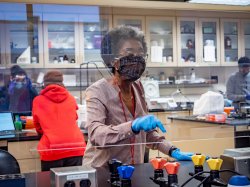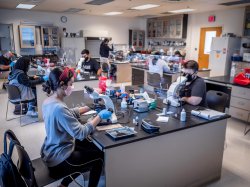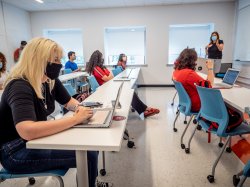Staying The Course
Lessons from the fall guide planning for spring 2021
Posted in: University

Montclair State is staying the course for spring 2021, inviting students back to live and learn on campus and continuing to balance on-campus and remote work and study when classes begin on February 8.
While looking back at lessons learned this past fall, five Montclair State faculty and students who shared how they are navigating this unprecedented academic year are also looking ahead to how those experiences of teaching and learning remotely and in-person – or a combination of the two – will guide them this spring.
“It doesn’t make sense to pretend these are not extraordinary circumstances,” says Mark Clatterbuck, acting chairperson for Religion.
The spring semester will see more frequent COVID-19 testing for students, staff and faculty in high-contact programs like athletics, the arts, and in residence halls and will continue to expand the coronavirus-combatting protocols – the daily Hawk Check health assessments, contact tracing, social distancing and mask wearing – put in place with the University’s restart plan. In addition, any student, faculty or staff member can get a free COVI9-test on campus this spring if they need one.
There are signs in New Jersey that the virus’ winter peak will be on the decline when classes resume in February. There’s also hope that the rollout of the COVID-19 vaccine will soon become more accessible to faculty, staff and students. And the 3,000 students expected to live in the residence halls are encouraged to stay on campus, except for work responsibilities, once they arrive, in order to minimize the risk of bringing the virus back with them.
“I hear that students are nervous about coming on campus. I think that’s good. That’s smart. That means you’re not taking the virus lightly,” says Emily J. Isaacs, executive director of the Office for Faculty Advancement. And there is no evidence from the fall term that there was any spread of COVID from a classroom setting. Contact tracing conducted by the University suggests that most of the cases on-campus stemmed from infections acquired off-campus – a key reason for residential students to remain on campus as much as possible.
“I feel that the University had planned well enough to make it safe for us to be here,” says Biology Professor Sandra Adams.
Take a look inside Biology Professor Sandra Adams’ molecular biology lab.
The Office for Faculty Advancement has led 75 training workshops preparing for spring 2021 for the multiple ways courses are being presented, Isaacs says. Some are entirely remote, some are entirely in-person, and some are a mixture of online and on-campus delivery.
“When the pandemic first hit, we knew we had to come up with a strategy for fall 2020,” Isaacs says. The result is a system called HAWKFlex, which provides for the range of instructional delivery options. Faculty and students have chosen the modality that works best for them as learners and as disciplinary experts.
During the fall – and continuing this spring – about 30% of undergraduate classes were taught on campus, mostly in a hybrid format. “At first we were nervous,” says Isaacs, who is also a professor of Writing Studies. Faculty worried how they would manage the technology and if they would be heard under their masks.
“But like everything, after a while it became routine. We opened our office door, we organized our materials. We went to our classroom, we turned on our technology. I think every faculty member found teaching pretty powerful because it mattered,” Isaacs says.
“Most of us are not working on the front lines as health-care workers or scientists,” she adds. “But what we can do is deliver instruction. We can think about the next generation and we throw ourselves into our teaching like never before.”

Biology Professor Sandra Adams says she was committed to learning as much as she could about using technology before students arrived last fall, attending training workshops and practicing using Zoom sessions in a classroom and connecting software to project information to students who were at home. She recorded lectures in advance and posted them to Canvas, repeating the information in class for virtual learners and students who were in class separated by Plexiglass in a carefully organized science lab.
“Students overcame the challenges because they had multiple opportunities to learn in a situation in which it didn’t matter whether or not they got the right answer,” Adams says. “The process was most important.”
Preparing for the spring, the University surveyed students, asking them directly about their experiences, Isaacs says.
“What we found perhaps most obviously – but yet profoundly – was that learning involves relationships. Some students struggled with the relationship building with the professor, but even more so with their peers,” Isaacs says. “It’s hard to learn alone. It takes an expert student to really build a relationship in an online environment. So what we’re thinking about for the spring is how do we make it easier for us to be in relationship to one another?”
Diana Maldonado, a sophomore pursuing a Theatre BFA with a concentration in Acting, says with online classes “you have to put yourself in that mindset. Last fall, I would wake up an hour before class, have breakfast, turn on my lamp and make sure I had a pillow to fix my posture in my chair. A lot of the responsibility was on me to make it feel like I was in a classroom.”
Her after-class routine was just as important. Maldonado says she would look out the window or go for a walk “to remind myself that I do exist, that I have some impact on the world outside my bedroom.”
One of the greatest challenges of life under COVID-19 is just feeling isolated, Clatterbuck says. “Students are isolated from their friends, isolated from their social networks, and in some cases, their sports teams, their religious communities. I think finding ways to build a sense of community, of engaging students, is critical to making it through this.”

In his online classes, Clatterbuck discovered some surprising benefits. “Some of those students who weren’t normally comfortable speaking up in a classroom setting in front of other people seemed comfortable doing that from their living room or bedroom with their cat walking across the keyboard,” he says.
Another surprise came in the online discussion boards. Students found a voice virtually and contributed with “passion, intensity and personal investment that I wasn’t expecting,” Clatterbuck says.
Lessons Learned
“Our experiences were not without problems,” Isaacs says. “Faculty members were exhausted. Students were exhausted. But in terms of student learning, we achieved our goals.” In an analysis of student performance comparing the falls 2019 and 2020, “it was interesting to see we don’t have the grade differences we feared.”
An important part of the process was being honest and having conversations with students. “We’re dealing with modalities that are new and we established ground rules to be gracious,” Clatterbuck says. “When things arise that feel like a glitch, or when Zoom cuts out or the mic isn’t working, you don’t need to freak out. We’re going to keep learning through it.”
Kingsley Maduka, a freshman majoring in Molecular Biology, says “the main lessons I learned that I’ll take into my spring semester is balancing, prioritizing and being more resilient. Balancing my schoolwork, my social life, clubs and extracurricular activities, but mainly my education, making sure I work to my fullest potential. In the world we live in right now, with this pandemic and these restrictions, it can try to hold you back. In my spring semester, I’ll work 10 times harder to make sure that I’ve overcome every single challenge and be the best me I can be.”
Story by Staff Writer Marilyn Joyce Lehren
You May Also Like:
